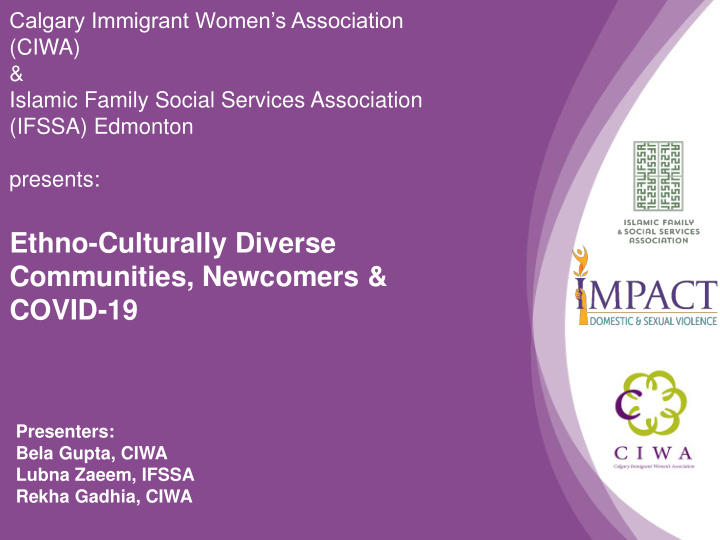



Calgary Immigrant Women’s Association (CIWA) & Islamic Family Social Services Association (IFSSA) Edmonton presents: Ethno-Culturally Diverse Communities, Newcomers & COVID-19 Presenters: Bela Gupta, CIWA Lubna Zaeem, IFSSA Rekha Gadhia, CIWA
Agenda • Introductions • Defining domestic violence • Factors leading to DV within immigrant/refugee families • Impact of Covid-19 • Relaunch/preparing for future • Q and A
Defining Domestic Violence Client perspective Frontline worker perspective
Defining Domestic Violence The CDVC defines domestic violence as: “The attempt, act or intent of someone within a relationship, where the relationship is characterized by intimacy, dependency or trust, to intimidate either by threat or by the use of physical force on another person or property. The purpose of the abuse is to control and or exploit through neglect, intimidation, inducement of fear or by inflicting pain. Abusive behavior can take many forms including: verbal, physical, sexual, psychological, emotional, spiritual, and economic and the violation of rights. All forms of abusive behaviour are ways in which one human being is trying to have control, exploit and/or have power over another.”
DV in the Ethnocultural Population Types and • Situational Causes of • Coercive control Violence • Collectivistic versus Barriers for the Individualistic Victims • Cultural Safety
Types of violence Situational Violence Coercive Control Cultural barrier Isolation Language barrier Monitoring activity Fear of being judged Restricting autonomy Fear of deportation/sponsoring Gaslighting Financial barriers Name calling Lack of social/economic success Controlling money Level of integration Reinforcing rules Fear of losing cultural & religious Manipulating kids values Controlling body Family honor Threats/jealousy Change in gender roles Communication control
Barriers for ethnocultural victim to leave Canadian laws and community services (lack of knowledge) Calling police?? What will the I can’t community say? leave… Here … and back home? My father says, “Accept your destiny. Stay with your husband”.
Barriers for ethnocultural victim to leave Collectivistic versus Individualistic culture • The collectivist values put priority on family and community • A complex and multi-dimensional family system • IDENTITY is closely tied to family and community
Barriers for ethnocultural victim to leave Cultural Safety • Concept introduced in New Zealand by nurses in 1980s • Recognize and Respect the cultural identities of others, and safely meet their needs, expectations and rights • Culturally unsafe practices are those that "diminish, demean or disempower the cultural identity and well- being of an individual“ ( Nursing Council of New Zealand 2002, p. 9).
Typical service provision gaps Shelters: • space • language barrier and cultural sensitivity • lack of long term support (housing) Family support: • support for immigrant men • support for immigrant children/secondary victims of violence • perpetrator engagement in education Specialised culturally sensitive counseling • unaffordable for low income families • gender specific counselors Lack of special considerations • religion • spirituality Service coordination/Case management
Impact of Covid-19 Increased risks: • Technology control • Assessing “real” safety • Safety planning • Family setting • Fear of virus • Emergency housing • Added stress factors
Preparing for future Adjusted ways to mitigate the new risk factors • Revisit safety planning • Gauge who else in family is around (in-laws, partner); during greetings ask about everyone in the family staying at home • Video calls to be preferred way of virtual service delivery (to assess casually that their physical space is safe and secure) • Educate clients about the signals for help
Engaging men and boys • Providing customized support for males • Creating a safe place • Male support groups • Gender equity workshops • Group sessions focusing on prevention and awareness
Moving forward with best practices Counseling support: Customised supports individual/couple/group emergency housing support first language (interpretation and emergency food translation) transportation support culturally sensitive childcare provision support groups (men/women/couples) parenting after violence rebuilding lives (family) accessible service locations in-home support Strategic partnerships Outreach shelters police service Community children's services education/awareness foodbank Engaging men and boys collaborative efforts (e.g. CDVC) health Services active networks (e.g. MAN-C) support groups Evidence based tools gender equity workshops Risk and protective factor survey healthy relationships sessions
Questions
Contact us: Lubna Zaeem Email: lubnaz@ifssa.ca Rekha Gadhia Email: rekhag@ciwa-online.com Bela Gupta Email: belag@ciwa-online.com
Recommend
More recommend